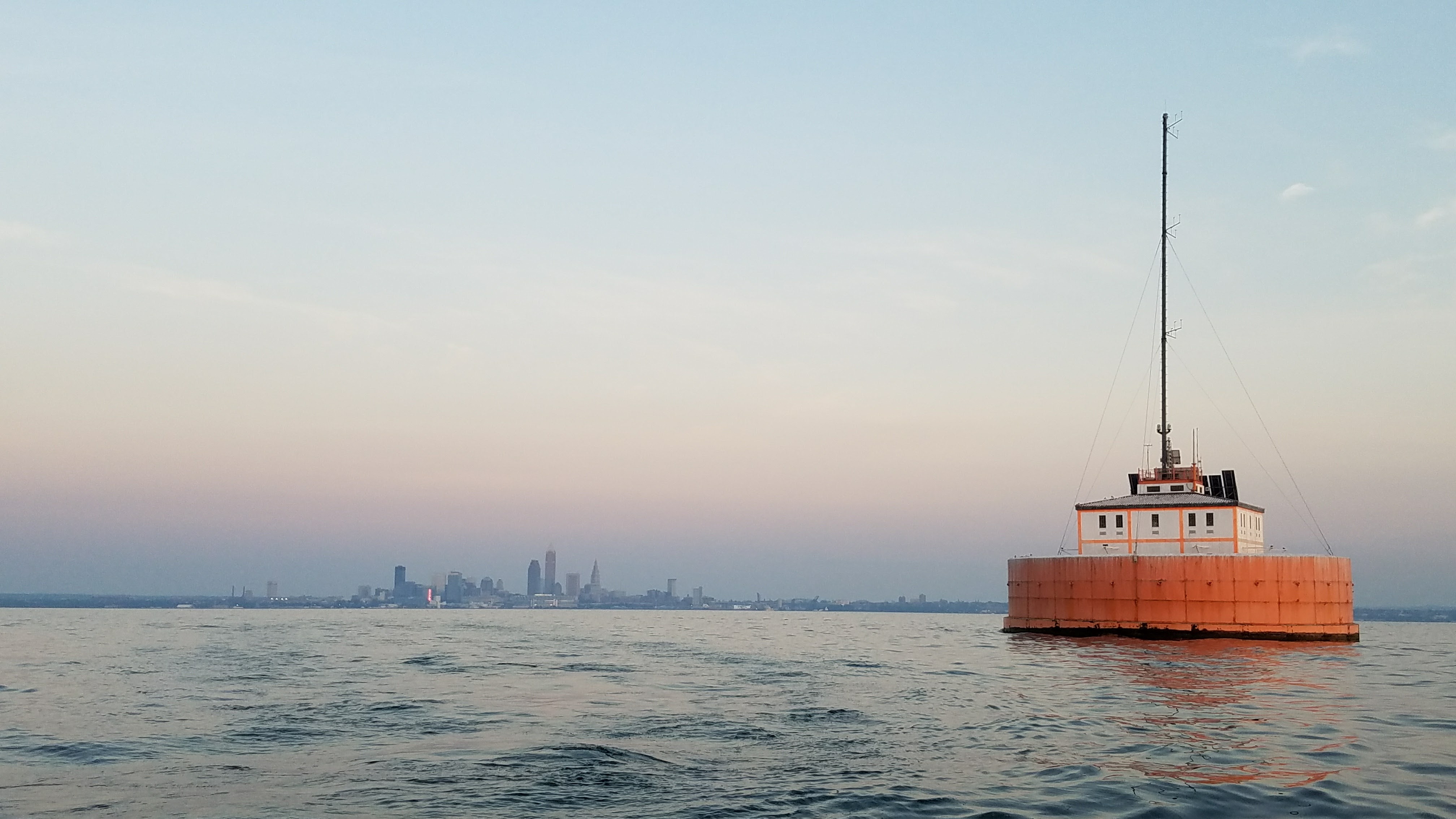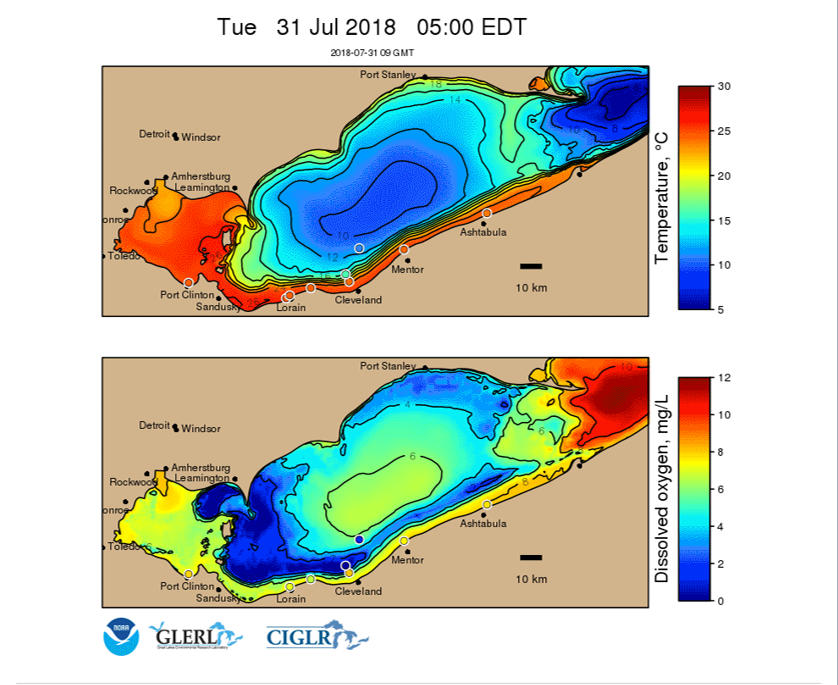Fall 2018 eNewsletter
Spotlight
Stakeholder Engagement Success Story: Cleveland Water

Cleveland Skyline and Cleveland Water Intake Crib. Daily, about 165 million gallons of water leaves Lake Erie through the crib to the pump station, where the water will begin treatment before it flows to other water facilities. Photo Credit: Ed Verhamme.
“It all started with a buoy,” says Steve Ruberg, the Observing Systems and Advanced Technology Branch Chief at NOAA GLERL.
In 2005, scientists from CIGLR and NOAA GLERL deployed a Realtime Coastal Observation Network (ReCON) buoy in Lake Erie near Cleveland, Ohio, to monitor oxygen levels, meteorological parameters, waves, currents, and temperature. For the Cleveland Water Department (CWD), this NOAA buoy was deployed just in time. The following year, CWD experienced a prolonged hypoxic (low oxygen) event at their water intakes, creating conditions that made treatment of drinking water difficult. CWD began working with Steve Ruberg (NOAA GLERL) and colleagues to find out more about the causes and effects of the hypoxic water in an effort to ensure the delivery of safe drinking water.
“We began working with the CWD, sharing data collected from the ReCON buoy and hosting presentations about Lake Erie and hypoxia to the local water intake managers,” says Ruberg. “In 2007, we re-deployed the ReCON buoy and have been working with the CWD ever since to provide real-time data to drinking water plants and the public.”
Founded in 1856, the CWD has worked tirelessly to provide reliable, safe, and excellent-tasting water to the city of Cleveland and surrounding areas. Serving more than 1.5 million customers in 80 Northeast Ohio communities, the CWD strives to be a leader in its community and the industry, and that means collaborating with NOAA GLERL and CIGLR to produce cutting-edge Lake Erie research.

Scott Moegling, Water Quality Manager for Cleveland Water. Photo Credit: Cleveland Water.
In 2015, the CWD hired current Water Quality Manager Scott Moegling, who has been a champion of this research partnership. Scott joined the CWD as an already-accomplished water quality professional, having spent 20 years as Ohio EPA’s Northeast District lead engineer in drinking water where he gained considerable Lake Erie treatment experience.
“Scott has been very interested in how the Lake Erie system works and how he can use the buoy data to make better water processing decisions,” says Ruberg. “This is a big change from 2006 when our group was just starting to help the CWD and their local water managers understand the physics and inner workings of Lake Erie. Scott already knows a lot about the Lake Erie system.”

Researchers from CIGLR and NOAA GLERL monitor the predicted changes in bottom water temperature and dissolved oxygen in Lake Erie and maintain a real-time forecasting interface on the web through the Experimental Lake Erie Hypoxia Forecast (click on image to see forecast page).
One year after Scott joined the CWD, a team of scientists led by Mark Rowe and Craig Stow (NOAA GLERL) sought Scott’s help to develop an experimental hypoxia forecast for Lake Erie to improve predictions for when and where hypoxia will occur, how it moves around the lake, and ultimately, when it may impact water utilities, such as the CWD. The team now has the capacity to inform drinking water treatment managers when they are likely to experience hypoxic water at their facilities, allowing them to prepare for adjustments to their treatment process.
“Our research group is developing a tool that will be applicable for the whole Lake Erie water industry, not just the scientific community,” says Moegling. “That’s what makes this project so special.”
Currently in the second year of the five-year grant, the experimental hypoxia forecast model is becoming more refined. Thanks to the valuable information gained from engaging with the CWD and other Lake Erie drinking water facilities, Dr. Mark Rowe has been able to improve forecasts for the extent, severity, and duration of Lake Erie hypoxia events.
“I am looking forward to the next 3 years and the future of this forecasting model,” says Moegling. “Our group frequently calls and emails one another with new information. It has been great to see people from completely different worlds work together to provide the best water possible to the customers. I foresee the CWD collaboration with CIGLR and colleagues to continue well into the future, even past this project. Scientific modeling is an important part of understanding our environment and how our lake works. If you can’t quantify it, you can’t manage it.”
“Scott has been a great collaborator and excellent to work with. He is genuinely curious about Lake Erie and wants to make the best decisions possible when it comes to the water that the CWD provides to its citizens,” states Ruberg. “We look forward to many more years of working together.”
About the Project
The experimental hypoxia forecast research team includes scientists with expertise in ecology, environmental chemistry, and hydrodynamic modeling from CIGLR (Tom Johengen, Casey Godwin) and NOAA GLERL (Mark Rowe, Steve Ruberg, Craig Stow). CIGLR’s Engagement Specialist, Devin Gill, works directly with public water utilities to facilitate co-design of the Experimental Lake Erie Hypoxia Forecast. Collaborators include the City of Cleveland Division of Water, Purdue University, and U.S. Geological Survey, with guidance from a management advisory group including representatives from Ohio public water systems, Ohio EPA, Great Lakes Observing System (GLOS) and NOAA. Funding for this research is supported by a $1.4 million award from the NOAA National Centers for Coastal and Ocean Science (NCCOS) Coastal Hypoxia Research Program (CHRP), NA16NOS4780209.
Related Resources
- Cleveland Water Department (webpage)
- Hypoxia Early Warning Research (webpage)
- Experimental Lake Erie Hypoxia Forecast (webpage)
In the News
- Forecasting Lake Erie Hypoxia, CIGLR Summer eNewsletter, 9/13/2018
- Lake Erie Dead Zone Threatens Cleveland Drinking Water, Metro News, 7/26/2018
- Experts monitoring Lake Erie’s surface, water quality to stay ahead of algal blooms, Cleveland 19 News, 6/26/2018
- Forecasting ‘Dead Zones’ to Help Protect Drinking Water, Great Lakes Connection / Connexion Grands Lacs Newsletter, 8/4/2017
- Update on Lake Erie Hypoxia Forecasting Stakeholder Workshop (May 23, 2017), NOAA Great Lakes Environmental Research Laboratory’s Blog, 6/28/2017
- Tracking Harmful Algal Blooms in Lake Erie, NOAA Research News, 9/23/2015
